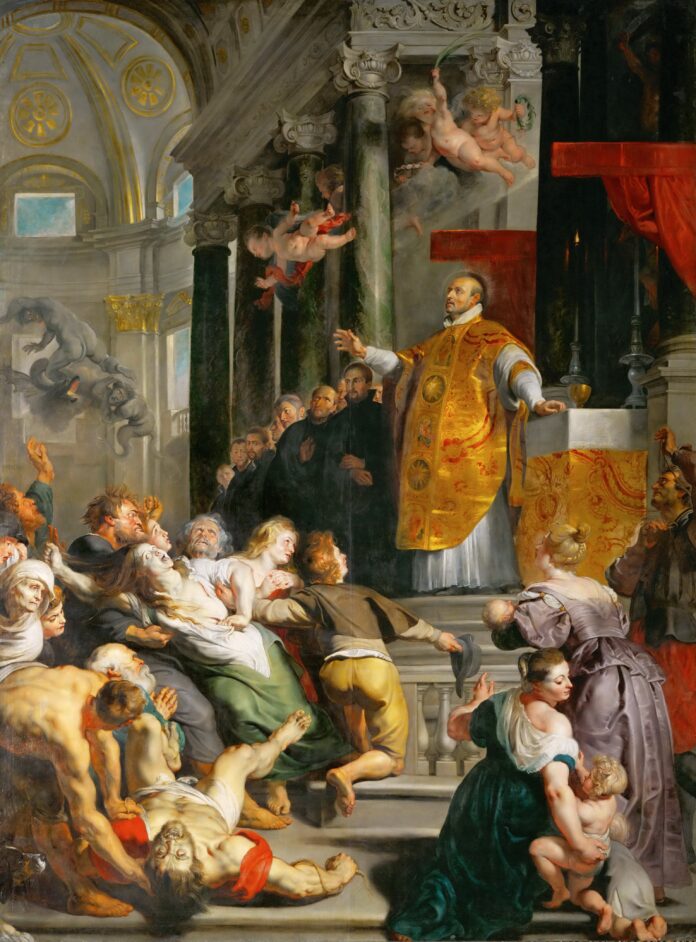![]()
“This people honoureth me with their lips: but their heart is far from me. And in vain do they worship me, teaching doctrines and commandments of men.” (Mt. 15, DR)
Georgetown students are barraged with tired and worn out phrases like “Jesuit values” and “Ignatian heritage.” What do they even mean?
Generally, these phrases appear in emails from the University promoting some vague form of do-good-ism, or a University-sponsored event whose connection to Catholicism is obscure at best.
Following the July 31st feast of St. Ignatius of Loyola, founder of the Society of Jesus, it is important to identify what true Jesuit values are, and to what degree the University actually upholds them.
For this, we must understand the character of St. Ignatius. Iñigo, as he was christened, was born into semi-nobility in the service of the contador mayor to the Catholic Monarchs of Spain, Ferdinand and Isabella, at the close of the XVth century. As a youth he dallied around the court, fantasizing about the chivalrous romances he read in his young days. The evidence would seem to suggest he lived an immoral life, and that his later confessions were not merely pious exaggerations. As a young adult, he took to service in the military. Though not yet a serious Catholic, he displayed many natural virtues like honor and fortitude in and out of combat.
Many Georgetown students are likely familiar with the story of Iñigo’s conversion, that is, when a cannonball to the legs led to a long convalescence in doctoral care. During this, he would not complain, but endured the painful injury and ensuing procedures with great patience. In his boredom, he wished to return to the romances which enlivened his youth, but none were to be found in his dwellings. Instead, lives of the saints and spiritual works were given to him, which was the spark that lit the flame of his conversion.
As Iñigo grew in holiness through repentance and prayer, he was certainly a changed man. Yet he continued to possess those virtues which distinguished him as a soldier. As St. Thomas teaches, gratia non tollit naturam, sed perficit; that is, grace does not destroy (or “take,” more literally) nature, but perfects it. God, through the operation of grace in Iñigo’s life, kept and perfected those good qualities with which he was endowed by nature and augmented them, while discarding the vices by which he had been ensnared as a young man. This is how grace operates within all of us as well, if given the chance.
Though converted, Iñigo remained a knight at heart. Through his journey into the science of sanctity, followed by his study of the natural sciences, he maintained the soldier’s psyche, though now in service of a much greater King. This attitude was centered on obedience, honor, courage, and most of all, a veneration for the transcendent and incarnate Truth. These things could properly be said to be the Jesuit Values.
Thus, in the first few centuries of the Jesuit order, those who made themselves the Pope’s soldiers for the propagation of the faith and the care of the poor, took their mission to the world. St. Edmund Campion martyred (witnessed) to the Faith in Elizabethan England, and through his erudition, courage, and overall embodiment of Jesuit Values, (ultimately concluding in his death by being drawn, hanged, and quartered) won many souls to Christ. St. Isaac Jogues, in his mission to the native Americans of French Louisiana, suffered the cannibalism of his primary fingers, torture, and more. Despite his treatment, he returned, determined to win those natives over to Christ, and suffered death for it. Bl. Miguel Pro gave a similar testimony to Christ by his martyrdom at the hands of an early XXth century Mexican tyranny. All of these Jesuits exhibited true Jesuit Values in its most profound sense; that is, they persevered undaunted through the world’s cruelty and dangers, and in doing so, conquered themselves and consequently death itself.
This total devotion to truth, through a unique brand of charity and cultural empathy, seems to have been lost. So what has gone wrong?
The easy answer would be to accuse the theological chaos of the last century surrounding figures and events like Teilhard de Chardin and the Second Vatican Council of being the perpetrators. However, the corrosion of this great order’s mission has roots far deeper than that, and there is likely no figure more responsible for this than John Carroll, Georgetown’s founder and America’s first Catholic bishop.
Throughout the counter-reformation period, the Jesuit order had become specifically tasked with combating heresy and spreading the faith where it was either on the retreat or where the seeds thereof had not yet been planted. In a way, they were the soldiers of religious orthodoxy. St. Thomas taught that heresy was perhaps more dangerous than physical violence. Worse than murder which kills the body, heresy kills the soul and spreads like a plague.1 The Jesuits, tasked with the salvation of the souls under their care, were just the men to stop the spread.
John Carroll showed signs of a betrayal of this mission early on. Jesuits, as a rule, were not supposed to accept high ecclesiastical office. But at the time of Carroll’s unprecedented election to the episcopacy, the Jesuit order was under formal suppression primarily for political reasons. Though the honest thing might have been to continue to follow the charism of the order to which his vocation called him, Carroll was bound by no such scruples. Nor was he scrupulous about his family’s barbaric ownership of slaves, a practice which had been continuously condemned by Rome since at least the XVth century, and by custom long before that. Carroll even further refused to take the oath which was part of the episcopal consecration which he was to undergo unless he was dispensed from the obligation to “extirpate heresy.” While this may seem uncontroversial to American readers who are accustomed to religious plurality, this abandonment of the Jesuit mission to uphold the transcendent Truth was a marked shift that would have great ramifications. This is implicitly a denial of the rights of Truth over error, and of the social kingship of Christ, an important Catholic doctrine. Turning his back on the Catholic view of the relationship between religion and society, Carroll embraced the American idea of “religious liberty,” which is ultimately a form of indifferentism. The Catholic teaching is clear that states and societies are under an obligation to acknowledge Christ as King. That is not to say that there must be a forced conversion of society, as that has never been the case, but that it is the right of Truth to hold a superior place to error in the estimation of the state. The American ideal was unavoidably a rejection of this.
Carroll’s embrace thereof infected the Catholic Church in America (and Georgetown in particular) with the heresy of Americanism, ultimately defined by its rejection of the social kingship of Christ and embrace of American-style individualism.2 Through the XXth century, the American Jesuits like Georgetown’s own John Courtney Murray who subscribed to this way of thought won greater influence in the Church (a fun fact: Murray was the architect of everyone’s favorite Problem of God course). Murray, along with some German comrades and a little help from the American government, were critical in getting the universal Church to seemingly embrace these ideals as well in the Second Vatican Council documents Gaudium et Spes and Dignitatis Humanae. Of course, as anyone who has a basic understanding of Catholicism knows, the traditional spiritual and moral teachings of the Church are immutable. However, the language of these documents is rather vague on the subject, and they consequently ignited great controversy. The Church, in its official teaching capacity, has been clear that it has not embraced “religious freedom” in the American sense, but is simply maintaining its position against forced conversion.3 Nonetheless, many within the hierarchy ignore the nuance present here and have embraced the error wholesale. It is as a consequence of this that we have a Church, and more specifically a university, that no longer seeks to challenge the world’s views with the Catholic Faith, but to affirm everyone in their current states.
There is no courageous witness to the faith. There are very few who seem to believe in the immutability and transcendence of the Truth enough to be willing to give their lives for it. Instead, this Jesuit courage and insistence on orthodoxy has been replaced by the religion of secular social justice. They have uncrowned Christ and relegated the Church to the role of a glorified NGO. Truth is relative and God is imminent, not transcendent.
St. Ignatius would be appalled.
So, in short, does the university live up to Jesuit Values, as it claims?
No, it does not. Instead, these values have been replaced with a facsimile version of quasi-marxist social justice that masquerades as Catholicism.
It is the duty of those of us who know better to distinguish the Truth from the lie, for the greater glory of God.
- Summa Theologica II-II, q. 11, a. 3. link.
- The most clear definitions and condemnations of Americanism are found in Pope Leo XIII’s encyclicals Longinqua Oceani (1895) and Testem Benevolentiae Nostrae (1899). It is also condemned explicitly in Pius IX’s 1864 Syllabus of Errors, which was an addendum to his encyclical Quanta Cura. As a young liberal, Fr. Joseph Ratzinger (later Pope Benedict XVI) saw the changes in Vatican II as a counter syllabus, demonstrating the incongruity of the American belief with that of the Church.
This argument is found primarily in the CDF’s response to a dubia posed by Archbishop Marcel Lefebvre over the contents of Dignitatis Humanae. The text of it, hard to come across, can be found here: link.












